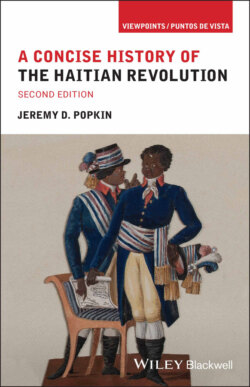Читать книгу A Concise History of the Haitian Revolution - Jeremy D. Popkin - Страница 18
Critics and Defenders of Slavery
ОглавлениеIn addition to the tensions generated by the slavery system and the conflicts between whites and the free people of color, Saint-Domingue in the years before 1789 was increasingly affected by new ideas coming from Europe and the newly independent United States. By the middle of the 1700s, some European thinkers were beginning to criticize slavery as an inherent violation of natural human rights. The idea of colonialism also came under fire. In 1770 the abbé Raynal’s Philosophical History of the Two Indies made a scathing denunciation of the effects of European settlement in the Americas. Subsequent editions of this best-selling work added vehement denunciations of slavery. One passage, written by the French philosophe Diderot, mentioned slave revolts in several colonies, warning that “these bolts of lightning announce the thunder,” and predicted that if slavery was not abolished, a black leader would soon “raise the sacred banner of liberty” and lead a movement to destroy the institution.9 Raynal’s book circulated freely in Saint-Domingue; it is often claimed that Toussaint Louverture had read it. Raynal himself had connections with royal administrators in charge of the colonies, and colonists feared that his ideas might influence official policy. Other critics challenged colonial policy on economic grounds, arguing that the cost of defending and administering overseas territories outweighed the profits they produced.
The French government’s actions during the decades before the revolution were confused and often contradictory. While some officials hoped to reduce the cruelty of slavery, others were more concerned about the possibility of blacks entering France itself. A 1777 edict, the police des noirs, expressed fears about racial mixing and set up a registration system meant to exclude blacks from the metropole.10 In Saint-Domingue itself, royal officials imposed new restrictions on the free population of color. The American Revolution added to the ferment under way in the New World. The conflict interrupted Saint-Domingue’s trade with Europe and its supply of new captives from Africa, reminding the colonists of their vulnerability to disruptions resulting from France’s foreign policy. White planters were alarmed when the French administration recruited free men of color to join a military expedition sent to besiege British forces in Savannah, Georgia, in 1779. Among the participants in this unsuccessful campaign were André Rigaud, who would later become Toussaint Louverture’s most important political rival, and a number of other figures who would play important roles in the events of the Haitian Revolution.
With the end of the American war in 1783, Saint-Domingue’s seemingly irresistible economic rise resumed. To make up for the cutoff of imported captives during the war, planters purchased record numbers of new African laborers, and a new wave of whites arrived from France. A decree in August 1784 opened Saint-Domingue’s major ports to trade with the newly independent United States. Eagerly welcomed by the colonists, this breach of the exclusif was bitterly opposed by French merchant interests. Although they appreciated the new trade law, the colonists were jolted when the French government issued ordinances on 3 December 1784 and 23 December 1785 intended to mitigate some of the worst abuses of the slave system. Masters and plantation managers were required to keep accurate records of the food and clothing provided to their slaves, and the provisions of the Code Noir allowing enslaved blacks to complain about mistreatment were restated. The colonists reacted violently to what they denounced as an example of metropolitan “despotism.” “This edict violates the sacred rights of property, and puts a dagger in the hands of the slaves, by giving control over their discipline and their regime to someone other than their masters,” one of them wrote.11 To silence this opposition, in January 1787 the French government shut down the Conseil supérieur, the main law court in Cap Français, and merged it with the court in Port-au-Prince. This measure further angered the white colonists, some of whom were ready to call for a revolt like the movement in 1768–9.
By the beginning of 1787, the French government’s attempt to deal with its growing financial problems had started the chain of events that would lead to a full-fledged revolution two years later. Saint-Domingue’s white colonists followed the stages of the pre-revolutionary crisis of 1787 and 1788 closely, and tried to calculate how to turn it to their own advantage. At the same time, they realized that they faced a new danger. In Paris in February 1788, a group of French reformers led by a well-known pamphleteer, Jacques-Pierre Brissot, founded the Society of the Friends of the Blacks. Inspired by the British campaign to abolish the slave trade, the Friends of the Blacks denounced slavery as a violation of natural rights. Its members, who included a number of wealthy aristocrats with properties in the colonies, shared the general European prejudice that blacks were the products of a primitive civilization. The society’s manifestoes called for a gradual phasing out of slavery that, its members claimed, would do no damage to the interests of slaveowners. Despite the moderation of its program, the Society of the Friends of the Blacks clearly underlined the contradiction between the ideals of liberty and equality that the self-proclaimed “patriot” movement in France was demanding and the realities of colonial life. The fact that the French government tolerated the society’s public meetings made the white colonists even more determined to defend their own interests.
